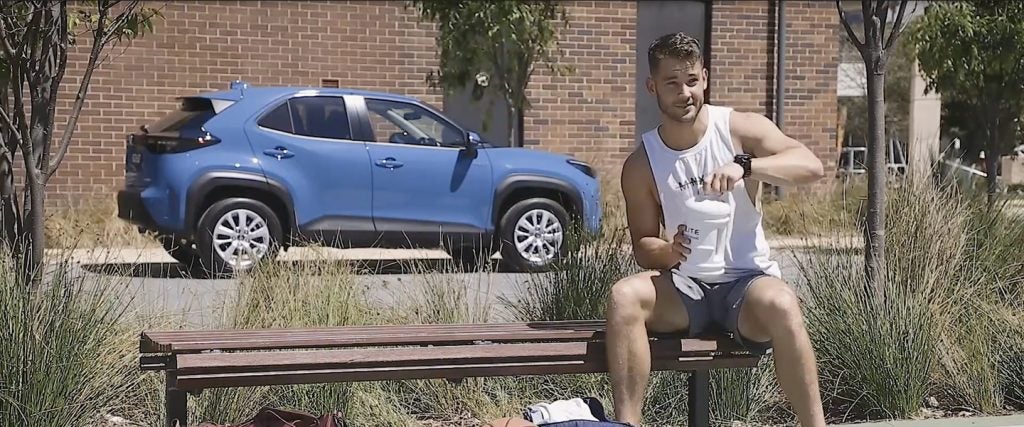At first glance, it’s a car review video like any other: Two guys drive around the Australian countryside in a Toyota Yaris, discussing the “cutting-edge” vehicle at length. After five minutes of lighthearted commentary, the camera suddenly pans to the roadside. There, straddling a bench and gulping thirstily from a huge water bottle, is a hot, hairy guy dressed in extremely short shorts. “Great review,” reads one comment. “Skillful incorporation of very hot scenery!”
Videos like these are commonplace on Gay Car Boys, an old-school motoring website that mixes articles on “talented twink” race-car drivers with in-depth vehicle reviews aimed at the queer community. If you’re looking for the most popular gay cars, you’re in luck, too — the site has tongue-in-cheek lists that sum up the popularity of various vehicles amongst the LGBTQ+ community. Some choices are aesthetically pleasing (the Ford Mustang has a “power lesbian” look, according to the site); others are propelled by cultural references, like the Jeep Wrangler’s affiliation with the gloriously filthy 1990s show Queer as Folk.
Primarily a passion project, Gay Car Boys was launched around 15 years ago by Alan Zurvas, a Brisbane, Australia-born car enthusiast. “I found there was a lot of resistance to anyone in the gay world who likes this kind of stuff, even though I’d say around 20 percent of motoring journalists in Australia are gay,” he tells me. In his experience, gay guys have long been reluctant to embrace the often hyper-masculine world of cars — as a result, brands have treated them as invisible.
Gay Car Boys was created to dispel the myth that car culture and queerness can’t co-exist, and to build an online forum for gay motoring enthusiasts to meet one another. It’s really taken off, too — as Zurvas tells me, the site has become so popular in the past decade that it’s become an authority on the niche subject, as well as resulted in various real-life LGBTQ+ car meetups across Australia. A few years back, Rolls-Royce even reached out to ask how they could better market toward gay consumers. (“You can’t really, people will just do what they want to do,” clarifies Zurvas.)
Although the site might seem irreverent, cars have been a constant source of solace for Zurvas. As a kid growing up in rural Australia in the 1960s and 1970s, he experienced “terrible homophobia” — back then, he explains, men who had sex with other men could be imprisoned for doing so. At 17, he came out as gay to his “scandalized” mom, but his dad “couldn’t have given a fuck either way.” Like his father, Zurvas had a deep interest in cars and motorcycles, and this shared passion kept them close. That same year, he fell in love with his first long-term boyfriend, who drove a Holden Sandman Panelvan. “We’d take a mattress with us and go away for long weekends,” he says. “I just loved it, and I started to realize I could retain facts about cars really easily.”
Throughout the 1970s, 1980s and 1990s, different Australian jurisdictions began to decriminalize homosexuality, although Zurvas says homophobia was still a regular occurrence. Then, the world was hit by corporate “pinkwashing” in the 1990s — as gay representation in mainstream media began to improve, companies started to see the LGBTQ+ community as a cash cow just begging to be milked. Brands like Subaru began creating ads with coded gay messages, like “Get Out. And Stay Out,” as well as images of signs for something called “Gay Street.”
Lesbians and Subarus became synonymous, and it soon became the stuff of meme legend — in one infamous ad (which may or may not be real), a lesbian is pictured on a poster, on which she claims to love the “attractive butch looks” and “manly engine growl” of Subaru’s Forester model. “It has lots of room to fit our Golden Retrievers, or the signs and posters for the Pride parade,” she boasted. “It’s the perfect car for our Alternative Lifestyle.”
By the late 1990s, Zurvas was starting to write for local Australian publications that were similarly interested in spotlighting gay perspectives. Cynical or not, in Zurvas’ eyes, the steady increase in gay-specific marketing was a welcome shift in the LGBTQ+ car landscape. “It would have been very easy to say, ‘Well, you didn’t want our fucking money before, you’re not going to get it now,’” he says. “But why throw the baby out with the bathwater? Just embrace it and say, ‘Okay, that’s great — we’re here.’”
That said, Gay Car Boys does plenty of digging to see which car companies are genuinely gay-friendly — and the fact is, not many are (at least outwardly). “Aside from Rolls-Royce, a lot of companies aren’t really forthcoming about having policies to protect us,” says Zurvas. “As for a brand’s stance on equality, it’s PR managers who get to make these decisions. Volkswagen’s PR team is incredibly gay-friendly, for example,” as evidenced by diversity campaigns like “Drive Proud.” Subaru has really put its money where its mouth is, too. In addition to their queer-friendly marketing, the company has also sponsored gay pride parades, partnered with queer-owned businesses and hired openly gay celebrities like tennis pro Martina Navratilova for its ad campaigns.
The site doesn’t just have an LGBTQ+ audience, though. “A lot of women read our site and tell us it’s because we’re not threatening and we don’t talk down to them,” Zurvas explains. In their eyes, it’s a way to escape the norms of what can often be a pretty misogynistic industry. “I’ve been shopping with girlfriends who want to spend their money, but dealers just ignore them completely and talk to me instead,” Zurvas continues. “We still live in a world where it’s a surprise to see a female mechanic or a female motoring journalist. In fact, there’s probably 50 times more gay male journalists in motoring media than there are women.”
There’s clearly still work to be done, but Gay Car Boys at least offers an outlet for people who want to read playful stories about a day in the life of a gay guy as well as a car’s technical specifications. “A lot of our gay friends are camera-shy, but let me tell you this: Queens just don’t fucking travel light,” he jokes. “Every time we take our gay friends on a road trip, there’ll be entire bags of pillows piled up in the back of the car.”
The tone of every review is deliberately conversational, and Zurvas manually approves every comment himself to make sure homophobic rants — and there are still plenty, he says — never make it online. It’s this no-bullshit approach to trolls that makes Gay Car Boys feel like an actual online community as opposed to just a review site. “If you’re offended by gay folk, then please move on,” reads a no-nonsense disclaimer on the site’s ‘About’ page. “We will have a fabulous time without you.”

